 |
Pyro
Universe
Fireworks
Info
How Fireworks Work
Pyrotechnic Glossary
Chemical Glossary
Fun With Fireworks
Safety Tips
Injury Statistics
Pictures
Pyro Links
Fireworks
Literature
Your Own Show
Getting Started
& Tips
Ignition & Fusing
Miscellaneous
Guest Book
Pyro
Projects
Before
you begin
Make your own
fuse
Re-loadable
mines
Skyrockets
Set pieces
Pyro
waterfall
Building
Projects
Firing
panel
Mortar racks
GROUND
ZERO
|
HOW
FIREWORKS WORK
Fireworks
function by the rapid chemical reaction (burning) of chemicals.
They require two basic ingredients - a fuel and an oxidizer.
Normally these two won't burn by themselves, but they will when
mixed.
Why do
fireworks need an oxidizer? Simply because the atmosphere we
breathe doesn't supply enough oxygen for them to work correctly.
Only about 20% of the air we breathe is oxygen, which is barely
enough to keep a match or bonfire going. Regular fire burns
relatively slow compared to fireworks. So in order to launch
into the air, spray sparks, or whatever, fireworks need an oxidizer.
A common oxidizer, potassium perchlorate, contains 4 atoms of oxygen
per molecule. When heated, the oxygen is released and burned by
the fuel. Additional chemicals can be added to create/deepen
color, sparks, strobes, and explosions.
When
pyrotechnic compositions are ignited, a large amount of gas is
produced, which either causes an explosion when confined (like
firecrackers) or releases gas to shoot something from a tube or
provide thrust like a rocket. The following list provides
information on how several different types of consumer/display
fireworks work.
AERIAL SHELLS
Aerial
shells are the most well known types of fireworks. These are what rise
into the air and create the magnificent colorful bursts of light seen at public
fireworks displays. A shell consists of a spherical ball or cylinder and a
lift charge. These are placed in large tubes sticking out of the ground,
known as mortars or guns. When ignited by the pyrotechnician, the lift
charge on the bottom of the shell - no more than a bag or cup full of black
powder - explodes, shooting the shell into the air like a bullet from a gun.
As the shell is rising upwards, a time fuse inside of it is burning towards the
burst charge. At the precise altitude, the shell explodes, blasting it
apart and igniting the color pellets (stars) on the inside. Display shells
(for professional use only) can range anywhere from 3 to 24 inches in diameter!
Shells generally go 100 feet up for every inch in diameter they are. Thus,
an 8-inch shell (shown here)
will go approximately 800 feet into the air before bursting.
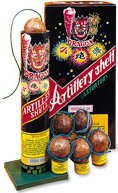 |
Smaller
shells are available for consumer use, which are usually 1.75 inches in
diameter. Consumer aerial shell kits contain 1 or 2 mortars
(tubes) and anywhere from 6 to nearly 40 shells. To fire a shell,
unwind the long fuse wrapped around it and carefully lower it flat end
first into the mortar. NEVER STAND OVER OR LOOK INTO THE TUBE.
Shells shoot up at several hundred feet per second - not something you
want to get hit in the face with should it accidentally ignite.
Now here comes the classic line: Light the fuse and get away.
Before firing another one, turn the tube upside down and kick it or hit
it against the ground to empty out any burning debris. The shell
should fit into the tube with no more than 1/8 inch or so between it and
the tubing. If there is too much space, the gas will escape and
the shell will not go as high. When a shell bursts, everything
inside burns up. The only "fallout" that comes back to
earth are harmless little strips of the paper casing. |
FIRECRACKERS
| Firecrackers
are the earliest form of fireworks. They were invented by the
Chinese, and were believed to drive away evil spirits.
Firecrackers are used in all Chinese holidays and festivals. They
consist of a paper tube filled with an explosive composition, usually
black powder or flash powder. The powder, when ignited, creates a
large amount of hot gas which blasts the tube apart with a loud bang.
Firecrackers come in strings from a dozen or so to rolls of a few
hundred. Very long strings, known as celebration rolls, contain
thousands of crackers. For the best effect, hang them up.
For a real big mess, light them while they're still in the paper
packaging. |
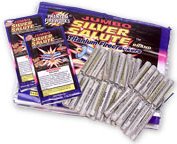
|
Do not
light and throw firecrackers from your hand. The fuse sometimes burns more
quickly than usual, which can turn into a real nasty experience when it burns
your finger or blows it off. A great deal of fireworks related
injuries result from this. Don't risk it.
GROUND SPINNERS
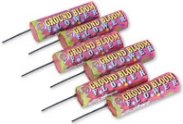 |
Ground
spinners spin around randomly at ground level, shooting out colored
sparks and flames. It works on the same principal as a rocket
engine. When the powder inside ignites, it creates a large amount of
gas, but rather than exploding, the gas and flames escape through the
hole in the side (called a choke). The thrust causes the device to
move and bounce around crazily on the ground. They must be used on
hard, flat surfaces to work correctly. |
FLYING SPINNERS
| Flying
spinners are basically ground spinners with slanted wings. As the
device spins, the wings direct the airflow downward and lift the thing
into the air like a helicopter. At the end of its flight, a small
burst charge ignites and ejects the colored stars inside.
Sometimes the whole thing explodes. Be
sure to use these on flat surfaces so it can spin around freely enough
to take off. Place it right side up so it actually becomes
airborne and doesn't just jump around. "Right side up"
means placing it so the hole the fuse goes into is facing the ground. |

|
NOVELTIES
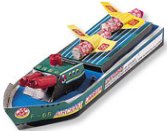 |
Novelties
are small fireworks that usually look like some real life object (such
as a frog, race car, ship, or tank) and often scoot across the ground.
They are one of the most harmless types of fireworks. You don't
need to get as far away as you would a typical firework, but then again,
don't get too close - some will unexpectedly shoot out little flaming
balls or emit a shrill, ear-splitting whistle. Children really
like these because they can use what's left over as a toy (or something
to stomp on). |
Novelties
move by using tiny rocket engines. When ignited, they expel hot gas out of
a tube, thus moving the device in the opposite direction. Whistling
sounds, from novelties such as Piccolo Petes, are created by gas rushing
through small, partly hollow tubes. The length of the tube determines the
pitch of the whistle. A Piccolo Pete's whistle gradually changes as
the powder burns farther and farther down the tube.
MINES
Not to be
confused with military weapons (i.e. land mines and naval mines), pyrotechnic
mines produce upward, fan-shaped blasts of color and effects. They are
placed into mortar tubes, just like aerial shells. Mines are usually only
seen in professional displays. There are very few mine products on the
consumer firework market.
Mines are
relatively easy to make. Click
here to
learn how to create your own mines.
REPEATING AERIAL
DISPLAYS
| Repeating
aerial displays, also known as repeaters and cakes, are one of the most
popular types of fireworks next to aerial shells. They are
basically a little firework show all in one piece. Although they
can be expensive, they are well worth the price. Their long
duration and variety of effects make them great crowd pleasers.
Repeaters usually consist of several tubes attached together, ranging
anywhere from half a dozen to nearly 100. Repeaters can be
distinguished from fountains because a repeater always has a fuse on the
lower side, rather than on the top like a fountain. Each tube of a
repeater is a tiny aerial shell type devices. A single fuse burns
between the tubes. When it reaches one, the lifting powder inside
ignites and shoots the effects high into the air. |
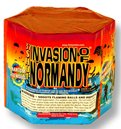
|
For
safety, always place tall repeaters within a concrete cinder block or surround
it with bricks so there's no chance of it tipping over. Shorter, fat
repeaters are pretty stable themselves, and don't need to have surrounding
reinforcements, but it wouldn't hurt to have them.
REPEATING
FOUNTAIN
 |
Repeating
fountains consist of multiple tubes, fused to go off in sequence.
As mentioned before, they can easily be confused with repeaters by their
shape, but your clue that they are fountains is that the fuse is on the
top, not the side. These usually provide even longer lasting
displays than regular single tube fountains, and can greatly improve
your show. Some pyros think fountains are childish and weak, but
they can greatly enhance a show, especially when used in combination
with shells or other aerial items. |
ROCKETS &
MISSILES
| These
devices blast up into the sky and eject some kind of effect; such as a
report, crackle, or stars. The tubes of these fireworks contain
thrust fuel with a cone-shaped hollow in the bottom so a large surface
area ignites, thus making it fly. A time fuse inside ignites the
payload at the peak of the rocket's flight. Rockets are stabilized
by a long stick, whereas missiles simply use fins. Missiles look
quite a bit like model rockets. Launch rockets from tubes
angled at no more than 15º from vertical. When launching
missiles, be sure it is on a flat surface, with no wind blowing to knock
it over. |
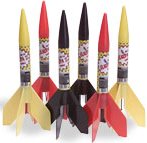
|
ROMAN CANDLES
 |
Roman
candles are a single tubes that fire many shots, unlike repeaters and
shells that only fire one shot per tube. They fire one at a time
out of a tube. The shots are like miniature aerial shells: they
can be anything from a color star to a small comet or a whistle.
The construction is complex, and consists of many layers. When the
fuse is lit, it ignites the lift charge below the shot, thus firing it
into the air. A delay charge burns around the next shot before
igniting it's lift charge and shooting it out of the tube. This
process repeats itself over and over again. |
Only place
roman candles in the ground or in a secure support, such as a pipe. DO NOT
hold them. They seem like they're pretty harmless to hold, but if one of
the shots were to get stuck in the tube, the whole thing could explode,
scattering pieces of paper and fingers everywhere.
SINGLE TUBE
FOUNTAINS
| Fountains
are devices that sit on the ground and emit showers of colored sparks
upwards. As the name implies, they consist of a single tube or
cone filled with pyrotechnic compositions. Unlike repeaters, they don't
shoot effects high into the air - only about ten feet. They
provide long-lasting displays of beautiful colors, and can greatly
enhance and complement aerial displays (like repeaters and shells). |

|
SPARKLERS,
SMOKES, SNAKES & STROBES
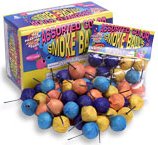 |
Smoke
and snake items are generally for daytime use. When snakes burn,
they emit a long, brittle carbon ash, which looks like a snake coming
out of the ground. They can be a real pain to ignite, unless you
use some sort of torch. They also leave a burn mark on the ground
that takes a long time to go away. Smoke items are a good daytime
item that are fun to play around with. Strobes make bright,
disorienting flashing of light. Some are supposedly colored, but
they all look white to me. Sparklers are tiny hand held fountains
that give off colored sparks from the burning tip. They are the
only firework meant to be held. |
DO NOT, I
repeat, DO NOT,
give sparklers to young children! The tips burn at up to 2000º. Two
thousand. They can cause horrible 3rd degree burns, and are one of the
leading causes of fireworks injuries simply because parents often give their
toddlers/little kids sparklers thinking that they are safe. Small children
have absolutely no common sense, and will try to cup their hand over the burning
end.
WHEELS AND SAXONS
| Wheels
are saxons are fireworks that are designed to be attached to some sort
of vertical support, usually by a nail. When lit, they spin around
their center emitting showers of sparks, crackle, and whistles.
They spin at incredible speeds, looking like a circle of blazing fire
floating in midair. Most wheels are powered by several engines
(called drivers) which fire in sequence. Saxons are wheels that
are stick-shaped, and are capable of actually making rings of color by
burning in multiple spots at one time. Make sure wheels and saxons
are securely attached to their supports slow they don't fly off when you
ignite them. |

|
Firework photos courtesy of Phantom
Fireworks. Used with permission.
colin@pyrouniverse.com
|
|